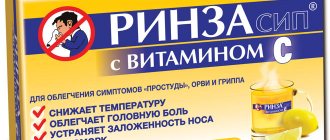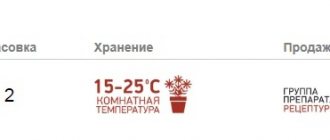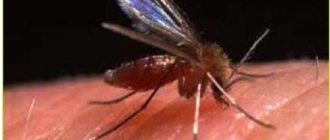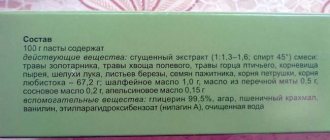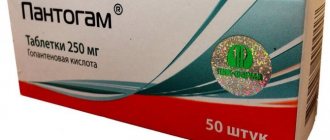Ingavirin for children is an antiviral agent that blocks the growth of infectious agents. The drug promotes the production of interferon, which prevents the virus from infecting body cells and multiplying in them. It provokes the growth of NK cells (natural killer cells), which recognize and destroy the virus and the cells affected by it. Before use, be sure to read the instructions for use of Ingavirin.
Composition of the drug
Ingavirin is available only in capsules. Yellow for children over seven years old, 60 mg each, red for adults and adolescents over 13 years old, 90 mg each. One package contains seven capsules, which is enough for a week's course of therapy.
The main active component of pentanedioic acid is imidazolylethanamide (abbreviated as vitaglutam). Ingavirin for children has the same composition of auxiliary components as for adults:
- Potato starch;
- Food additive E572 (magnesium stearate);
- Milk sugar;
- Polysorb (Aerosil);
- To apply the brand name, natural resin, titanium dioxide, and dioxypropane were used;
- The capsule consists of titanium dioxide, gelatin, and dye.
Composition and pharmacological properties
Since most viral infections are transmitted by airborne droplets, it is almost impossible to protect a child from infection. Ingavirin for children is an effective drug in the treatment of acute viral infections (ARVI), influenza viruses (B, A, A/H1 N1, A/H3N2, A/H5N1), and prevents the occurrence of complications after an illness. The drug is also used in terms of preventive methods for colds.
Distinctive features:
- has a gentle effect on the body;
- promotes rapid recovery;
- strengthens resistance to viral infections.
The active ingredient is vitaglutam (pentanedioic acid imidazolylethanamide). The composition includes excipients:
- potato starch;
- magnesium stearate – E572;
- milk sugar;
- polysorb;
- aerosil.
The composition of Ingavirin for children and adults does not differ, with the exception of the amount of active substance contained in one capsule (children - 60 mg, adult - 90 mg). This is worth paying attention to when choosing a drug to avoid overdose in children.
Vitaglutam activates the innate immune system by increasing interferon levels. The active substances stimulate the production of an antiviral protein, which blocks the process of viral replication. What is immunity and how to increase it in children, I saw from Dr. Komarovsky:
The maximum concentration level of Ingavirin occurs 30-35 minutes after administration. The drug immediately enters the bloodstream from the gastrointestinal tract (gastrointestinal tract), is evenly distributed throughout the internal organs, and has a complex effect. Ingavirin does not undergo the metabolic process and is excreted unchanged. ¾ of the drug exits through the intestines (defecation), ¼ through the kidneys (urine). The elimination process takes 23-24 hours.
Indications for use
Ingavirin can only be used against viral diseases, it does not fight bacteria. A bacterial infection can be recognized by purulent plaque on the child’s tonsils, or green nasal mucus. In this case, additional antibiotics are prescribed.
Indications for use for children and adults are the following infections:
- Flu;
- Parainfluenza;
- Adenovirus;
- Respiratory syncytial virus;
- Other ARVI.
Ingavirin 90 provides for the prevention of all types of influenza and other acute viral diseases in patients over 13 years of age.
Which is better for children - Kagocel or Ingavirin 60
Kagocel belongs to synthetic antiviral drugs from the group of interferon inducers. The drug has antiviral and immunostimulating effects.
The cost of a package of Kagocel is 260 rubles. The drug is produced by the Russian pharmaceutical company Nearmedic Plus.
Just like Ingavirin, Kagocel is used for the prevention and treatment of influenza and other acute respiratory viral diseases.
The mechanism of Kagocel's antiviral activity is based on its ability to stimulate the processes of interferon synthesis by the patient's body.
Kagocel is recommended for the treatment of patients over six years of age, however, if necessary, the drug can be prescribed to children over three years of age.
Read further: Instructions for Kagocel tablets + a lot of useful information
Instructions
Take the medicine orally with clean water. You can take the capsule regardless of food, but it is advisable to drink Ingavirin at the same time of day. A child's immune system is not as developed as an adult's, so it is important to start treatment on time.
Ingavirin 90 should be used according to the following scheme:
- For therapeutic purposes, children 7-17 years old are prescribed one Ingavirin 60 capsule per day (60 mg);
- Adults, for therapeutic purposes, are prescribed 90 mg per day;
- For prevention purposes, adults, immediately after contact with a suspected infected person, take 1 capsule every day for a week.
Begin treatment immediately after symptoms appear (cough, fever, runny nose), preferably no later than two days from the moment of infection. Depending on the severity of the infection, continue therapy for 5-7 days.
- Interesting read: neurotic cough in children
Children's Ingavirin 60 - instructions for use
The main active ingredient of Ingavirin can have antiviral and anti-inflammatory effects.
The anti-inflammatory effects of Ingavirin are due to its ability to inhibit the production of major cytokines with anti-inflammatory effects (tumor necrosis factor, alpha and beta interleukins, myeloperoxidase, etc.).
The antiviral effect of Ingavirin is realized due to the ability of the main active ingredient of the drug to actively suppress the reproduction of viruses.
Ingavirin also has a moderate immunomodulatory effect. It is able to increase the levels of protective proteins (interferons in the blood), stimulate the production of interferons by leukocytes, increase the production of lymphocytes that have a cytotoxic effect on viruses, and also increases the production of NK cells (natural killer cells with pronounced antiviral activity).
The antiviral activity of Ingavirin 60 is manifested against influenza viruses, parainfluenza, adenoviruses and respiratory syncytial viruses.
Therapeutic effects of the drug:
- reduction of the febrile period of the disease;
- reducing the severity of intoxication syndrome (headaches and muscle pain, weakness, drowsiness, etc.);
- reducing the severity of catarrhal manifestations of infection;
- reducing the risk of complications;
- reducing the duration of the disease.
The low toxicity and high safety profile of the drug were confirmed by special toxicological studies. When used in the dosages specified in the instructions, the drug does not have mutagenic, immunotoxic, allergenic, carcinogenic, terratogenic or embryotoxic effects. Also, the drug does not affect the reproductive system and fertility levels.
There are no cases of overdose of the drug Ingavirin.
Pharmacological group
Antiviral agent.
Is Ingavirin an antibiotic or not?
No. Ingavirin is not an antibacterial drug and does not act on bacteria. In this regard, Ingavirin for sore throat, otitis media, sinusitis, etc. do not apply.
Read further: When can you take antibiotics and antivirals at the same time?
Pharmacokinetic features of Ingavirin 60
The drug has a high level of bioavailability when taken orally and is quickly and sufficiently absorbed from the gastrointestinal tract.
After absorption from the gastrointestinal tract, Ingavirin is quickly distributed in the tissues of internal organs. Ingavirin penetrates best into the tissues of the kidneys, liver and lungs. It is accumulated in lower concentrations by the spleen, thymus, lymph nodes and adrenal glands.
On average, the drug is able to circulate in the blood for about 37 hours from the moment the last dose was taken. During a course of treatment, the drug accumulates in tissues and internal organs.
Ingavirin does not form active metabolites in the body and is excreted unchanged in feces (about 80% of the drug) and urine (about 20% of the drug).
Recipe for Ingavirin 60 in Latin
Rp.: Ingavirin 60
DTD No. 7 in caps.
S. 1 capsule 1 time per day.
Composition and release forms of Ingavirin
The antiviral drug Ingavirin is available in the form of capsules of 60 mg (Ingavirin for children) and 90 mg (Ingavirin for adults).
Photo of packaging Ingavirin 60 for children over 7 years old
In addition to the main active ingredient - pentanedioic acid imidazolylethanamide, Ingavirin contains auxiliary components (lactose, potato starch, magnesium stearate, dye, etc.).
What are Ingavirin 60 tablets prescribed for?
Ingavirin has antiviral, anti-inflammatory and moderate immunomodulatory effects. However, the drug affects only a limited range of viruses (influenza A and B types, parainfluenza, adenovirus and respiratory syncytial virus).
The drug can be used for the treatment and prevention of diseases caused by respiratory syncytial viruses, adenoviruses, influenza and parainfluenza viruses.
For prevention, the drug should be taken after contact with the patient. When treating with Ingavirin, it should be taken no later than 36 hours from the onset of symptoms of the disease.
Ingavirin for sore throat, otitis, sinusitis, bacterial bronchitis, etc. does not apply.
However, according to indications, Ingavirin and antibiotics can be taken simultaneously (usually for viral infections with a high risk of developing bacterial complications or when a secondary bacterial infection occurs against the background of a viral disease).
Ingavirin is not effective for rotavirus infection, since it has no effect on the pathogen.
Read further: Symptoms and treatment of rotavirus infection in children
Dosage of Ingavirin 60 for children
The drug is taken once (1 capsule) per day, regardless of food intake.
Ingavirin capsule (60 mg) should be washed down with a glass of boiled water at room temperature.
The duration of treatment is from five to seven days. When carrying out prophylaxis, the drug is also taken 1 time per day (1 capsule Ingavirin 60) for seven days.
The duration of treatment is determined by the attending physician, depending on the severity of the patient’s condition.
Treatment with Ingavirin should be started no later than 36 hours from the appearance of the first symptoms of the disease.
Contraindications to the use of Ingavirin 60
A contraindication to the use of Ingavirin 60 is the patient's intolerance to the components of the drug (the main active ingredient or auxiliary components). Also, Ingavirin 60 is not prescribed to children under 7 years of age. Children under 18 years of age are not prescribed Ingavirin 90.
Since the drug contains lactose, the drug is contraindicated in patients with congenital hereditary intolerance to lactase, galactose, glucose and patients with malabsorption syndrome.
Pregnant and breastfeeding women are not recommended to prescribe Ingavirin, since there is no data on the safety of the drug for the treatment of this category of patients.
The drug does not affect the reaction rate, so it can be used to treat drivers and people working with complex mechanisms.
Side effects from using Ingavirin 60
As a rule, the drug is well tolerated by patients. Undesirable effects from the use of Ingavirin 60 can be manifested by the development of allergic reactions (the appearance of rash, itching, urticaria, angioedema, etc.).
Contraindications
General contraindications:
- Children under seven years of age;
- Sensitivity to vitaglutam and its excipients;
- Lactose intolerance, lactase deficiency, galactosemia;
- Carrying a child;
- Breastfeeding (you should stop for the period of treatment, or choose another remedy);
- Concurrent use of another antiviral drug;
- Concurrent alcohol consumption.
The 60 mg formulation is not suitable for patients over 18 years of age. This is due to insufficient dosage for an adult body, and as a result, ineffectiveness of administration.
The 90 mg formulation is contraindicated for the treatment of viral infections in children under 13 years of age. Also, the use of adult dosage is not permitted for prophylaxis in children under 18 years of age.
Which is better - Ergoferon or Ingavirin
Ergoferon is a homeopathic remedy that stimulates the synthesis of interferon. The drug is produced by the Russian pharmaceutical company Materia Medica. The cost of packaging the product is about 350 rubles.
Ergofeon can be used to treat children older than six months. The antiviral effect of the drug is inferior to Ingavirin.
Side effects
With rare exceptions, an allergy to the active substance or auxiliary components is possible. No other side effects have been identified, the medicine is easily absorbed by both adults and children.
Ingavirin does not affect psychomotor reactions and does not have a sedative effect. Can be prescribed to people with work that requires increased concentration. No studies have been conducted on the ability to drive a car, but given the absence of side effects and sedative effects, taking the drug will not affect the quality of driving.
Possible side effects, compatibility with other drugs
It is strictly forbidden for people with individual sensitivity to the components to take the medicine. Side effects may include allergic reactions. In case of overdose of the drug, you should stop taking it and consult your pediatrician.
Ingavirin 60 for children is a complex antiviral drug. It can be taken independently, without complex therapy. However, if the patient has been diagnosed with bacterial ENT diseases, the intake should be supplemented with antibiotics. Ingavirin alone cannot cope with bacterial infections.
Compatibility with other drugs must be discussed with your doctor. You cannot apply complex therapy on your own. If the baby’s illness is accompanied by a cough, doctors often recommend therapeutic massage sessions.
Analogs
There is no completely identical drug. The active component of Ingavirin is unique; it is not found in other drugs for influenza and ARVI. But there are many antiviral agents that act similarly.
Analogues of Ingavirin for the treatment of children:
- Amizon tablets, for children over 6 years old, are prescribed one tablet per day, the dose depends on age;
- Amizonchik in the form of syrup, designed for ages 3-6 years. 5-7 ml (according to age group) three times a day;
- Arbidol in tablets 50 mg from three years, in capsules 100 mg from six years;
- Arbidol maximum in capsules from 12 years;
- Arbidol suspension, from two years, 10 ml four times a day;
- Anaferon can be given to babies from 1 month of age by dissolving the tablets in boiled water;
- Isoprinosine tablets, conditionally from three years, but the child’s weight must be at least 15 kg;
- Kagocel tablets, for children from three years old;
- ORVITOL NP in capsules, treatment and prevention of infections in children from three years of age;
- Panavir Inlight throat spray, approved from one year;
- Tilaxin and Tiloron are indicated for children at least seven;
- Tamiflu in capsules and suspensions, approved from one year;
- Ergoferon can be given for six months after dissolving the tablet;
- Cycloferon is prescribed to children at least 4 years old.
The above drugs have a number of contraindications, specific age-specific dosages and individual dosage regimens. If there are deviations from the age norms for the child’s weight, attention should be paid to the fact that the dose, in most cases, is prescribed according to age conditionally, based on the approximate weight. Therefore, before taking medications, you need to read the instructions and consult a therapist.
Which is better - Ingavirin or Amiksin
Amiksin is a synthetic drug from the group of interferon inducers. The product is produced by the Russian company Pharmstandard. The cost of a package of Amiksin is 670 rubles.
Amiksin IC is used for children over 7 years of age.
The mechanism of action of Amiksin is based on the ability of tilorone (the main active ingredient) to stimulate the synthesis of protective proteins (interferons).
Amiksin differs from Ingavirin in a wider range of applications. Amiksin can be used as part of complex therapy for herpes infections, viral encephalitis, chlamydial infections, for the treatment and prevention of influenza and other acute respiratory viral infections, etc.
Read further: Instructions for children's Amiksin 1C with analogues and reviews
Reviews
Reviews for Ingavirin are mostly positive. Parents note the rapid elimination of symptoms, and the child’s condition improves within two days. Negative reviews are most often associated with the late start of treatment, or improper use of the drug. The cause of ineffectiveness may be a previous infection that was not fully treated with Ingavirin. In this case, the virus becomes immune to the drug.
- Recommended reading: cytomegalovirus infection
Any medications, including Ingavirin, must be prescribed by your doctor. This is especially important when it comes to young patients. If the disease is neglected, therapy will be longer and complications may arise. Ingavirin is effective and safe for children, the main thing is to follow the dosage and not skip a dose.
General information about the drug
Ingavirin has been produced since 2009 by the domestic company Valenta Pharm. There are two types of the drug: with a higher dosage for adults and with a lower dosage for children. The medicine has antiviral and immunomodulatory properties. Effectively fights viral infections, including influenza types A and B, eliminates headaches and nasal congestion.

